|

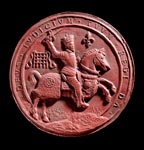 James VI wasted little time in proceeding to London once the news of Elizabeth's death reached him, heading south within two weeks. Before leaving Scotland he declared he would return every three years to Scotland, but in fact only visited once, fourteen years after his departure. James was more concerned with his much bigger and lucrative new realm. His visit north in 1617 is chiefly noted for his attempt to make the Church of Scotland adopt more Church of England like practices. James VI wasted little time in proceeding to London once the news of Elizabeth's death reached him, heading south within two weeks. Before leaving Scotland he declared he would return every three years to Scotland, but in fact only visited once, fourteen years after his departure. James was more concerned with his much bigger and lucrative new realm. His visit north in 1617 is chiefly noted for his attempt to make the Church of Scotland adopt more Church of England like practices.
While regarded as a capable Scottish king, he is viewed as less of a success as an English king. He did manage to avoid the calamitous pitfalls his son was later to fall into, especially regarding his decisions on religion and government. James did disappoint some religious groups, notably the Puritans, who hoped he would adopt the structure and ideals of the more radical Church of Scotland, and Catholics who hoped he would be more sympathetic to the church of his mother. He became less than moderate in dealing with them, leading to such dissatisfaction that Catholic rebels attempted to kill him through the Gunpowder Plot of 1605. His promise to “harry [Puritans] out of the land” led eventually to some of them becoming exiles, and then sailing as the Pilgrim Fathers to the New World.
Regulations for keeping the peace during the king's progress south, 1603
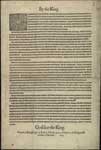 This proclamation, dated 5 April 1603, issued from Holyrood House, outlines arrangements made to safeguard his journey south from Edinburgh to take up residence in London. Local officials were ordered to meet the royal party as it arrived in their particular county. They had to provide food and accommodation, fresh horses and carriages and guard them throughout their journey from one county border to the next. Extra vigilance was to be kept against thieves, vagabonds or seditious people who might threaten the king's person and his party. No one was to approach the king carrying pistols or guns. This proclamation, dated 5 April 1603, issued from Holyrood House, outlines arrangements made to safeguard his journey south from Edinburgh to take up residence in London. Local officials were ordered to meet the royal party as it arrived in their particular county. They had to provide food and accommodation, fresh horses and carriages and guard them throughout their journey from one county border to the next. Extra vigilance was to be kept against thieves, vagabonds or seditious people who might threaten the king's person and his party. No one was to approach the king carrying pistols or guns.
During the 17th century, proclamations were used in a variety of ways. The crown often used them when parliament was not sitting or when crown and parliament failed to agree. Royal proclamations were used to create laws in relation to administration, defence and foreign affairs, commerce, social and religious life. Proclamations were also used as announcements or statutory declarations. So that no one in Scotland could claim ignorance, copies were printed and read aloud at mercat crosses and churches throughout the country.
James VI entering England
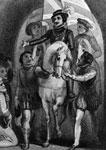 King James VI of Scotland entered England in April on his way to become King James I of England. It took him two months to reach London. His journey south saw crowds gathering to proclaim him. He walked to the Easter service at York Minister through the streets so that his people could see him. He later expressed his delight in seeing “mouths and tongues uttering nothing but sounds of joy.” During his journey south he is said to have knighted over 300 noblemen, heralding his damaging style of honouring favourites. King James VI of Scotland entered England in April on his way to become King James I of England. It took him two months to reach London. His journey south saw crowds gathering to proclaim him. He walked to the Easter service at York Minister through the streets so that his people could see him. He later expressed his delight in seeing “mouths and tongues uttering nothing but sounds of joy.” During his journey south he is said to have knighted over 300 noblemen, heralding his damaging style of honouring favourites.
Despite his welcome, there was some anxiety amongst both populations: the Scots fearful of losing their long time monarch, and the English wary of an uncouth Scots monarch replacing their 'Queen Bess'. James was crowned in Westminster Abbey, on Edward I's Coronation Chair (built to include the Stone of Destiny) on 25th of July, 1603.
Union flag
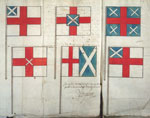 In 1603 when James VI of Scotland became James I of England, a new international entity was created: Great Britain. It needed a new flag. This manuscript, from around 1604, shows several designs which were considered, using combinations of the red and white cross of St George [England] and the blue and white saltire of St Andrew [Scotland] to symbolise what King James called 'this happy marriage'. These designs were considered by the Earl of Nottingham, one of the Union Commissioners, who preferred the lower middle design, considering it most fitting to the dignity of both nations. In 1603 when James VI of Scotland became James I of England, a new international entity was created: Great Britain. It needed a new flag. This manuscript, from around 1604, shows several designs which were considered, using combinations of the red and white cross of St George [England] and the blue and white saltire of St Andrew [Scotland] to symbolise what King James called 'this happy marriage'. These designs were considered by the Earl of Nottingham, one of the Union Commissioners, who preferred the lower middle design, considering it most fitting to the dignity of both nations.
Edinburgh Castle
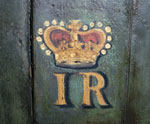 The palace had suffered from artillery bombardment in the Lang Siege in 1573 (when the King's forces had besieged supporters of his mother) and major works therefore had to be carried out to make it fit for the king to stay in on his one and only return to Scotland in 1617. Apart from the refurbishment of the Great Chamber, two new floors were built providing royal apartments for the King and Queen Anne, a Crown Room and other State apartments. The palace had suffered from artillery bombardment in the Lang Siege in 1573 (when the King's forces had besieged supporters of his mother) and major works therefore had to be carried out to make it fit for the king to stay in on his one and only return to Scotland in 1617. Apart from the refurbishment of the Great Chamber, two new floors were built providing royal apartments for the King and Queen Anne, a Crown Room and other State apartments.
This painted decoration 'IR' ('Jacobus Rex') was added in 1617 specifically for the King's visit. When his mother, Mary, Queen of Scots, had taken up residence in April 1566, her apartments consisted of the Great Chamber, a large Inner Chamber, and a small room called the Cabinet. It was in this Cabinet that the prince James was born.
James VI on throne
 James ruled believing fully in the sole power of the monarch, the “Divine Right of Kings”. He dissolved Parliament for having the temerity to discuss foreign policy, an area of government he felt was the King's prerogative. His extravagance and lavish treatment of his favourites did not endear him to many, and there is no doubt his strong accent and manner were not what the English court were used to. James ruled believing fully in the sole power of the monarch, the “Divine Right of Kings”. He dissolved Parliament for having the temerity to discuss foreign policy, an area of government he felt was the King's prerogative. His extravagance and lavish treatment of his favourites did not endear him to many, and there is no doubt his strong accent and manner were not what the English court were used to.
While James is well regarded as a monarch, particularly in Scotland, he is chiefly remembered for the figure who united the two kingdoms. The unifying of two previously warring nations in a peaceful – if not wholly lauded - manner is his main legacy.
|

















